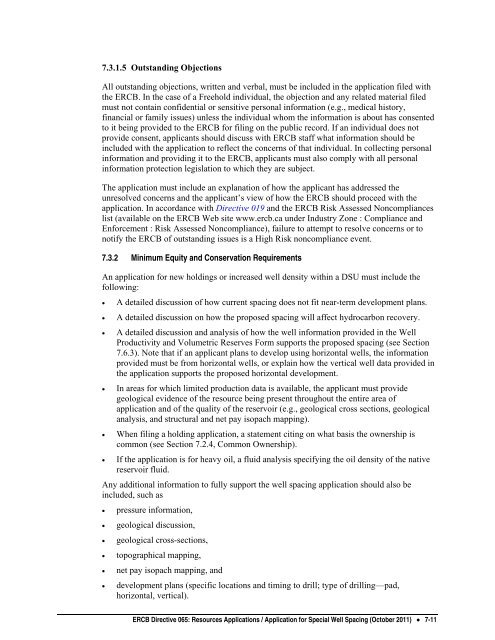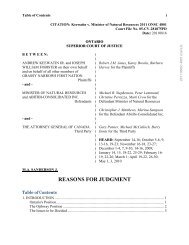Directive 065: Resources Applications for Oil and Gas Reservoirs ...
Directive 065: Resources Applications for Oil and Gas Reservoirs ...
Directive 065: Resources Applications for Oil and Gas Reservoirs ...
Create successful ePaper yourself
Turn your PDF publications into a flip-book with our unique Google optimized e-Paper software.
7.3.1.5 Outst<strong>and</strong>ing Objections<br />
All outst<strong>and</strong>ing objections, written <strong>and</strong> verbal, must be included in the application filed with<br />
the ERCB. In the case of a Freehold individual, the objection <strong>and</strong> any related material filed<br />
must not contain confidential or sensitive personal in<strong>for</strong>mation (e.g., medical history,<br />
financial or family issues) unless the individual whom the in<strong>for</strong>mation is about has consented<br />
to it being provided to the ERCB <strong>for</strong> filing on the public record. If an individual does not<br />
provide consent, applicants should discuss with ERCB staff what in<strong>for</strong>mation should be<br />
included with the application to reflect the concerns of that individual. In collecting personal<br />
in<strong>for</strong>mation <strong>and</strong> providing it to the ERCB, applicants must also comply with all personal<br />
in<strong>for</strong>mation protection legislation to which they are subject.<br />
The application must include an explanation of how the applicant has addressed the<br />
unresolved concerns <strong>and</strong> the applicant’s view of how the ERCB should proceed with the<br />
application. In accordance with <strong>Directive</strong> 019 <strong>and</strong> the ERCB Risk Assessed Noncompliances<br />
list (available on the ERCB Web site www.ercb.ca under Industry Zone : Compliance <strong>and</strong><br />
En<strong>for</strong>cement : Risk Assessed Noncompliance), failure to attempt to resolve concerns or to<br />
notify the ERCB of outst<strong>and</strong>ing issues is a High Risk noncompliance event.<br />
7.3.2 Minimum Equity <strong>and</strong> Conservation Requirements<br />
An application <strong>for</strong> new holdings or increased well density within a DSU must include the<br />
following:<br />
• A detailed discussion of how current spacing does not fit near-term development plans.<br />
• A detailed discussion on how the proposed spacing will affect hydrocarbon recovery.<br />
• A detailed discussion <strong>and</strong> analysis of how the well in<strong>for</strong>mation provided in the Well<br />
Productivity <strong>and</strong> Volumetric Reserves Form supports the proposed spacing (see Section<br />
7.6.3). Note that if an applicant plans to develop using horizontal wells, the in<strong>for</strong>mation<br />
provided must be from horizontal wells, or explain how the vertical well data provided in<br />
the application supports the proposed horizontal development.<br />
• In areas <strong>for</strong> which limited production data is available, the applicant must provide<br />
geological evidence of the resource being present throughout the entire area of<br />
application <strong>and</strong> of the quality of the reservoir (e.g., geological cross sections, geological<br />
analysis, <strong>and</strong> structural <strong>and</strong> net pay isopach mapping).<br />
• When filing a holding application, a statement citing on what basis the ownership is<br />
common (see Section 7.2.4, Common Ownership).<br />
• If the application is <strong>for</strong> heavy oil, a fluid analysis specifying the oil density of the native<br />
reservoir fluid.<br />
Any additional in<strong>for</strong>mation to fully support the well spacing application should also be<br />
included, such as<br />
• pressure in<strong>for</strong>mation,<br />
• geological discussion,<br />
• geological cross-sections,<br />
• topographical mapping,<br />
• net pay isopach mapping, <strong>and</strong><br />
• development plans (specific locations <strong>and</strong> timing to drill; type of drilling—pad,<br />
horizontal, vertical).<br />
ERCB <strong>Directive</strong> <strong>065</strong>: <strong>Resources</strong> <strong>Applications</strong> / Application <strong>for</strong> Special Well Spacing (October 2011) • 7-11
















